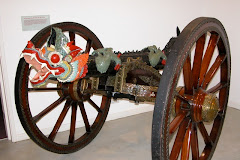
These copper alloys are easier to work than iron, which requires a higher melting temperature in order to make cast iron or a skilled blacksmith for wrought iron. Casting in copper is relatively straightforward and needs little imagination, but we will come to that presently. Let's start with wrought iron.
In Europe in the days before iron could be melted, it was worked by heating it to a glowing red and hammering it on an anvil. That is how horseshoes are made and the procedure for making guns followed the same path. Manufacture began with a sheet of iron that had been hammered out from a block and then wrapped around a mandrel - a solid cylindrical block of the required calibre for the gun itself. This formed the inner 'tube' or lining of the gun. Long rods of iron made like staves were then laid out along the length of the gun and held in place by a series of iron hoops. These were slipped into place while still hot, so that as they cooled and shrank, they tightened the rods in place. This built-up construction produced a tube open at both ends. Onto one end was fitted a 'breech block', often in the shape of a beer mug, complete with a handle and a vent hole. Holding that in place was usually a suitably shaped mounting carved out of a solid block of wood, while the rest of the gun was strapped tightly to that same mounting.

This construction, using long staves and hoops, was very similar in concept to the cooper's method of making wooden casks. Another name for a cask is a barrel - hence the name 'barrel' for the long tube of a gun!
This method of making guns was extremely laborious and the guns themselves tended to leak gas pressure, especially around the breech area, and were frequently not strong enough, blowing apart and injuring the gunners who served them.
Casting guns in copper was much preferred, though copper itself was expensive and had to be imported into England from the Continent. The skills also had to be imported and it was Henry VIII who had the wealth and determination to do just that, persuading a Venetian gunfounding family, the Arcana, to come to England and start making guns for the King. The procedure was relatively simple in concept, if rather more complex in practice.
It began with the making of a maquette - an exact replica of the external dimensions of the gun, complete with decoration (see picture), made in clay. This was actually made on a former - a length of wood wrapped in coils of thin rope, then covered in clay. When the maquette had dried, it was lightly greased and then the mould was built up around it in clay. When this, too had dried, the maquette was broken out of the mould - this was where the rope coils came in, since these could easily be pulled out, together with the former, leaving just the relatively thin clay to be broken away.

The mould was then thoroughly dried before being buried in a casting pit, muzzle end upwards, for the molten metal to be poured into it. In the years before the late 18th Century, a metal rod would be placed inside the mould and secured so that the molten metal would run around it, forming the inner shape of the barrel. However, it was found that casting the piece as a solid and drilling out the bore of the gun produced a stronger barrel.






